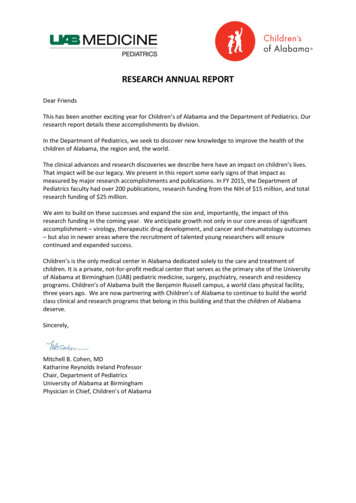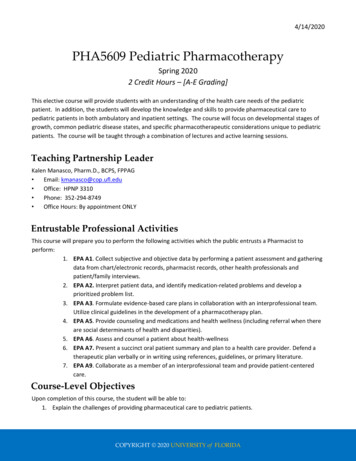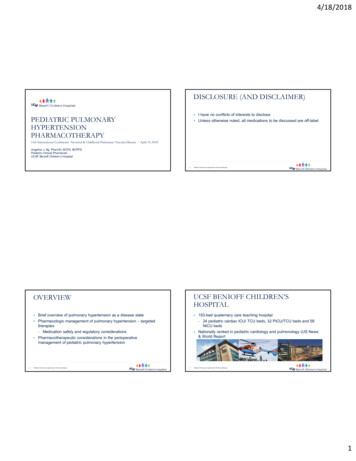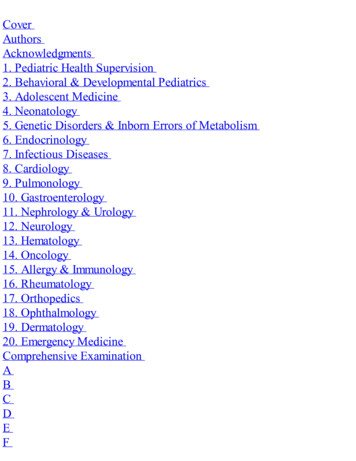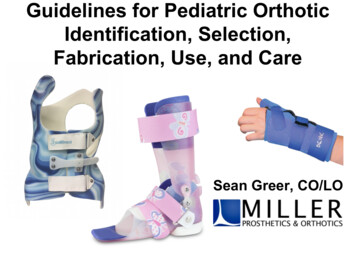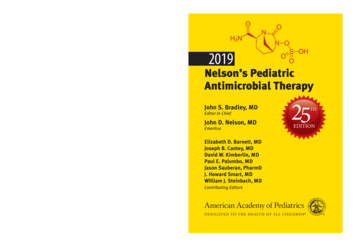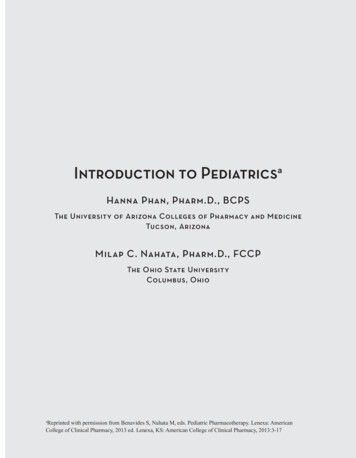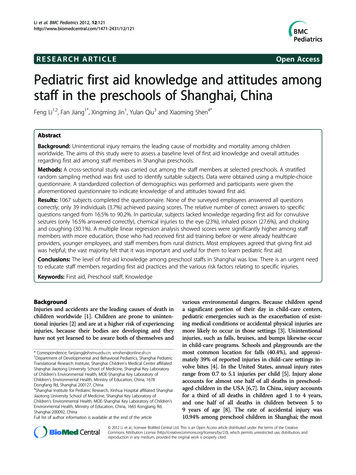
Transcription
Li et al. BMC Pediatrics 2012, 1RESEARCH ARTICLEOpen AccessPediatric first aid knowledge and attitudes amongstaff in the preschools of Shanghai, ChinaFeng Li1,2, Fan Jiang1*, Xingming Jin1, Yulan Qiu3 and Xiaoming Shen4*AbstractBackground: Unintentional injury remains the leading cause of morbidity and mortality among childrenworldwide. The aims of this study were to assess a baseline level of first aid knowledge and overall attitudesregarding first aid among staff members in Shanghai preschools.Methods: A cross-sectional study was carried out among the staff members at selected preschools. A stratifiedrandom sampling method was first used to identify suitable subjects. Data were obtained using a multiple-choicequestionnaire. A standardized collection of demographics was performed and participants were given theaforementioned questionnaire to indicate knowledge of and attitudes toward first aid.Results: 1067 subjects completed the questionnaire. None of the surveyed employees answered all questionscorrectly; only 39 individuals (3.7%) achieved passing scores. The relative number of correct answers to specificquestions ranged from 16.5% to 90.2%. In particular, subjects lacked knowledge regarding first aid for convulsiveseizures (only 16.5% answered correctly), chemical injuries to the eye (23%), inhaled poison (27.6%), and chokingand coughing (30.1%). A multiple linear regression analysis showed scores were significantly higher among staffmembers with more education, those who had received first aid training before or were already healthcareproviders, younger employees, and staff members from rural districts. Most employees agreed that giving first aidwas helpful; the vast majority felt that it was important and useful for them to learn pediatric first aid.Conclusions: The level of first-aid knowledge among preschool staffs in Shanghai was low. There is an urgent needto educate staff members regarding first aid practices and the various risk factors relating to specific injuries.Keywords: First aid, Preschool staff, KnowledgeBackgroundInjuries and accidents are the leading causes of death inchildren worldwide [1]. Children are prone to unintentional injuries [2] and are at a higher risk of experiencinginjuries, because their bodies are developing and theyhave not yet learned to be aware both of themselves and* Correspondence: fanjiang@shsmu.edu.cn; xmshen@online.sh.cn1Department of Developmental and Behavioral Pediatrics, Shanghai PediatricTranslational Research Institute, Shanghai Children's Medical Center affiliatedShanghai Jiaotong University School of Medicine, Shanghai Key Laboratoryof Children’s Environmental Health, MOE-Shanghai Key Laboratory ofChildren's Environmental Health, Ministry of Education, China, 1678Dongfang Rd, Shanghai 200127, China4Shanghai Institute for Pediatric Research, Xinhua Hospital affiliated ShanghaiJiaotong University School of Medicine, Shanghai Key Laboratory ofChildren's Environmental Health, MOE-Shanghai Key Laboratory of Children'sEnvironmental Health, Ministry of Education, China, 1665 Kongjiang Rd,Shanghai 200092, ChinaFull list of author information is available at the end of the articlevarious environmental dangers. Because children spenda significant portion of their day in child-care centers,pediatric emergencies such as the exacerbation of existing medical conditions or accidental physical injuries aremore likely to occur in those settings [3]. Unintentionalinjuries, such as falls, bruises, and bumps likewise occurin child-care programs. Schools and playgrounds are themost common location for falls (40.4%), and approximately 39% of reported injuries in child-care settings involve bites [4]. In the United States, annual injury ratesrange from 0.7 to 5.1 injuries per child [5]. Injury aloneaccounts for almost one half of all deaths in preschoolaged children in the USA [6,7]. In China, injury accountsfor a third of all deaths in children aged 1 to 4 years,and one half of all deaths in children between 5 to9 years of age [8]. The rate of accidental injury was10.94% among preschool children in Shanghai; the most 2012 Li et al.; licensee BioMed Central Ltd. This is an Open Access article distributed under the terms of the CreativeCommons Attribution License (http://creativecommons.org/licenses/by/2.0), which permits unrestricted use, distribution, andreproduction in any medium, provided the original work is properly cited.
Li et al. BMC Pediatrics 2012, 1common injuries included falls, collisions and extrusions, and sprains [9]. Compared to non-school-basedemergency medical service (EMS) incidents, schoolbased EMS incidents are more often attributable to injury, more often related to a sports activity, and moreoften result in transport to a medical facility [10]. Mostinjuries in preschools are require only first aid treatment[11]; therefore, preschools are important locations tofocus on the prevention of injuries and diseases in children, because situations requiring first aid are oftenencountered there. Leila et al. described the first aidused and resulting clinical outcomes of all patients whoarrived at a children’s hospital with an acute burn injuries [12]. They found that correct first aid was associatedwith significantly reduced re-epithelialization time forchildren with contact injuries; likewise, some positiveclinical outcomes were associated with correct first-aiduse. This shows there is a need for a higher publicawareness of correct first-aid treatments. Administeringcorrect and timely first aid to patients after accidents isvital and can potentially save lives [13,14]. In schools,staffs are often first-aid providers it has become important to determine the current perceptions held by schoolstaff concerning children’s accidents [15].Trained individuals who are closest to the scene of theaccident should administer first aid, first aid training forregulated day care providers may contribute to children'shealth and safety [16]. A pediatric first aid training program for the staff members at Shanghai preschools hasalready begun. This program will equip all 35,000 currentpreschool employees in Shanghai with medical first aidknowledge and skills. Concurrent with the training program, a baseline survey was conducted on the preschoolstaff members. The goal of the current study was thereforeto use questionnaires to evaluate preschool employees'knowledge of and attitudes toward first aid measures forthe management of ill and injured children.MethodsSubjectsThis study included employees working in preschools inShanghai, China. In China, no distinction is made betweenpreschools and day care centers. Preschools in China operate on a full-day basis and thus serve as both an educational and childcare institutions. There are a total of 1193preschools in Shanghai, employing 35,000 teachers,healthcare providers (persons with some medical knowledge; they are generally not doctors), and directors.Shanghai has 18 districts and one county; a stratified random sampling method was used to obtain 1282 subjects.The number of staff members in each district or countywas selected based on the proportion of staffs in the district or county. Of the total 35,000 preschool employees inShanghai, 54.2% work at public schools, 29.1% at privatePage 2 of 7schools, and 16.7% at other types of schools. In each district or county, preschools are classified as public, private,or other. In the district or county, the employees fromeach preschool category were selected according to theproportion of the types of schools present in the districtor county. A local children’s hospital undertook the stratified sampling process. The selected 1282 employees wereinvited to meet at the children’s hospital with help fromthe local education authorities. Finally, 1067 of 1282volunteers participated in this study. A cross-sectional survey was conducted to assess subjects for the first aid management of ill or injured children using a self-filledquestionnaire. The participants were not allowed to checkany reference materials. All participants provided writteninformed consent. The institutional review board ofShanghai Children's Medical Center approved this study,and the research was carried out in compliance with theHelsinki Declaration.ProceduresThe data were collected by questionnaire, which wasdivided into three sections. Section A focused on demographic information of the participants. Section B wascomprised of 37 simple-choice questions on the knowledge of the treatment of common children’s emergencies. The questions were written using a PedFACTstextbook [17] and an instructor's resource manual published by American Academy of Pediatrics [18]. Participants were instructed to select the best answer from achoice of four options. One point was awarded for eachcorrect answer, with no credit given for unansweredquestions or an answer of “Not Sure”. Total scores werecomputed as a sum of each item score and then standardized to a range of 0–100. A score of 80% or greater wasrequired to pass, in accordance with examination guidelines from the American Academy of Pediatrics. SectionC addressed attitudes toward first aid, including threequestions apiece on attitudes towards learning and alsoadministering first aid. Participants responded using afive-point scale ranging from disagreement to agreement(1 – Completely Disagree; 2 – Partly Disagree; 3 – Neutral;4 – Partly Agree; and 5 – Completely Agree.). Thesequestions were taken from another first-aid trainingstudy [19]. For the percentages of those who agreed,codes 4 and 5 were combined; for percentages of thosewho disagreed, codes 1 and 2 were combined.Data analysisAll data were entered into the Statistical Package for theSocial Sciences for Windows (Version 11.0, Chicago, IL,U.S.) for statistical analysis. The results of the questionnaire are expressed as frequency distributions and werecomputed in percentages. A comparison of the scoresbased on groups was performed with an analysis of
Li et al. BMC Pediatrics 2012, 1Page 3 of 7variance or Student's t test as needed. A multiple linearregression analysis was performed to assess the independent contributions of factors associated with theknowledge scores: age, district (urban/rural), type ofschool (public/other), highest level of education (highschool and below/college and above), staff category(healthcare providers/teachers), and previous first aidtraining (received/not). P 0.05 was considered statistically significant for all analyses.ResultsSection A: demographic informationA total of 1067 subjects participated in and completed thisstudy. Of the sample group, 0.3% of the subjects were maleand 99.7% were female. In our samples, 66.7% of participants were employees at public schools, 21.8% at privateschools, and 10.5% at other types of schools. There was nostatistically significant difference between our sample andthe total preschool staff in Shanghai (χ2 3.848, P 0.146).A total of 69.2% of the group had not taken any first-aidtraining courses before. The demographic characteristicsof the participants are listed in Table 1.Section B: KnowledgeThe average scores differed significantly across staffcategories. Healthcare providers had higher scores(Table 1). Subjects who had received first-aid training before had a higher level of knowledge than those who hadnot. The average scores were significantly different amongparticipants from different districts, participants of different ages, participants from different preschools, and participants who had different levels of education (Table 1).None of participants surveyed answered all questionscorrectly. An average score of 56.7 12.4 was documented. Only 39 individuals (3.7%) achieved passing scores.Accurate answers to each specific question ranged from16.5% to 90.2% (Table 2). Subjects especially lackedknowledge regarding first aid for convulsive seizures(only 16.5% aware), chemical injuries to the eye (only23% aware), inhaled poison (only 27.6% aware), chokingand coughing (only 30.1% aware), and bites to thetongue (only 38.8% aware). Only 21% knew to first survey the scene when dealing with an accident. Correctresponses regarding first-aid for fainting (41.2% in total,44.1% of healthcare providers, 36.5% of teachers) andheatstroke (42.1% in total, 41.7% of healthcare providers,42.7% of teachers) were also low. When faced with casesof inhaled poison, only 27.6% of staff described appropriate first aid. Accurate responses to first aid on othercommon emergencies are shown in Table 2.Results of the multiple linear regression analysisshowed the knowledge score to be significantly higheramong staff who had higher education levels (t 2.069,P 0.039), who were from rural districts (t 3.785,P 0.001), who had received first aid training before(t 2.506, P 0.012), those who were already healthcareproviders (t 4.546, P 0.001), and younger personnel(t 4.185, P 0.001) (Table 3).Table 1 Demographic characteristic of the staff and average scores of subgroupsCharacteristicsN (%)Mean SDDistrict (N 1067)Urban591 (55.4%)55.3 12.1Rural476 (44.6%)58.5 12.6 30304 (28.5%)59.4 12.131–40369 (34.6%)57.5 12.1 41394 (36.9%)53.8 12.3Age (years) (N 1067)Highest education level (N 1064)High school or below278 (26.1%)54.1 11.6College or above786 (73.7%)57.7 12.5Healthcare providers662 (62.0%)58.2 12.4Teachers405 (38.0%)54.3 12.1No738 (69.2%)55.8 12.5Yes327 (30.6%)58.9 11.9Public722 (67.7%)57.5 12.5Others345 (32.3%)55.0 12.1Staff categories (N 1067)Received first aid training* (N 1065)Types of school (N 1067)*Those with unknown data for the specified characteristics are excluded from this table.t/FP18.031 0.00119.091 0.00117.643 0.00125.582 0.00114.521 0.0019.5620.002
Li et al. BMC Pediatrics 2012, 1Page 4 of 7Table 2 Relative number of correct responses to study questionsFirst aid knowledgeHealthcare providers No. (%)(N 66)Teachers No. (%)(N 405)Total, No. (%)(N 1067)Convulsive seizures——position the child onhis left side first119 (18.0)57 (14.1)176 (16.5)Survey the scene first in the accidents143 (21.6)81 (20.0)224 (21.0)Inhaled poison——remove the child fromthe toxic area first203 (30.7)91 (22.5)294 (27.6)Chemical injury to eye——put on disposablegloves and flush the chemical from the eyewith lukewarm water158 (23.9)87 (21.5)245 (23.0)Choking and coughing child——do nothing,except reassure the child and observe thechild closely202 (30.5)116 (28.6)318 (30.1)Caring for a choking child, call EMS after 2 minutesof performing first aid care253 (38.2)142 (35.1)395 (37.0)Bites to the tongue ——apply pressure witha piece of gauze or cloth to stop the bleeding296 (44.7)118 (29.1)414 (38.8)Fainting——lay the child on his or her backand loosen any tight clothing292 (44.1)148 (36.5)440 (41.2)Heatstroke——cool the child immediatelyand call EMS276 (41.7)173 (42.7)449 (42.1)reduce infection by flushing the injured areawith running water;289 (43.7)169 (41.7)458 (42.9)before CPR, determine that breathing andcoughing are absent346 (52.3)211 (52.1)557 (52.2)Insect stings——move the child to a safe areaand remove any stingers387 (58.5)212 (52.3)599 (56.1)Nosebleeds——pinch the soft parts of the noseand press against the bones of the face423 (63.9)211 (52.1)634 (59.4)Penetrating injury to eye——call EMS408 (61.6)230 (56.8)638 (59.8)Percentage of correct responses from 30%Percentage of correct responses from 30% to 60%Percentage of correct responses 60%Punctures——Soak the wound in clean water455 (61.2)250 (61.7)655 (61.4)Swallowed poison——remove traces ofthe poisonous from the child’s mouth firstand then call EMS444 (67.1)270 (66.7)714 (66.9)Bleeding——place firm, direct pressure onthe wound472 (71.3)250 (61.7)722 (67.7)Dog bites——care for the wound andcheck with animal control officer496 (74.9)248 (61.2)744 (69.7)Spinal injury——avoid moving the child at all,and keep the neck and back aligned524 (79.2)327 (80.7)851 (79.8)Burns——place the burned area in cool water552 (83.4)318 (78.5)870 (81.5)Electrical burns——turn off the powersource if possible and call EMS554 (82.2)335 (82.7)879 (82.4)Bone injury——rest and call EMS562 (84.9)341 (84.2)903 (84.6)Keeping dangerous materials inan inaccessible place and locked up605 (91.4)353 (87.2)958 (89.8)Swelling——apply cold, then wrapand elevate the injured body part614 (92.7)348 (85.9)962 (90.2)
Li et al. BMC Pediatrics 2012, 1Page 5 of 7Table 3 Multiple regression analysis of factors associatedwith score of knowledgeStandard errortP-value0.7660.3702.0690.039 1.0540.278BetaCollege education or aboveUrban districts 3.785 0.001Received first aid training before 0.7900.3152.5060.012Working at a public school0.2870.3110.9210.357 0.7810.187 4.185 0.0011.3820.3044.546 0.001AgeHealthcare providersSection C: AttitudesFor attitudes towards administering first aid, the majorityfelt positive toward providing first aid. Regarding attitudestowards learning first aid, the vast majority felt that it wasimportant and useful skill for them to learn (Table 4).DiscussionThe results of our study indicate overall staff knowledgeof first aid to be lacking, evidenced by the low but visiblefrequency of incorrect responses to common illnessesand injuries. The American Academy of Pediatrics hasset 80% as the passing level in its written knowledgeexam of pediatric first aid training for caregivers andteachers. According to that criterion, only 3.7% of thesurveyed teachers had an adequate knowledge of firstaid. Questions related to splinters (incorrect rate: 61.4%),nosebleeds (59.4%), Insect stings (56.1%), fainting(41.2%), reducing infection by flushing the injured areawith running water (42.9%), heatstroke (42.1%), bites tothe tongue (38.8%), inhaled poison (27.6%), and chemicalinjury to the eye (23.0%) were most often answered incorrectly. With regard to a child swallowing poison, ifthe victim vomits, the insulting substance may causemore damage as it passes through the esophagus a second time. Induction of emesis is wrong and harmful[20], but many of the study participants thought it appropriate. In cases of poisoning, 33% of the staff members in our study would not take both the child and thepoison bottle directly to the hospital. In the presentstudy, the rate of correct answers to questions aboutconvulsive seizures was lowest; only 16.5% of responderswould act to first protect the head. Similarly, Dantas inBrazil demonstrated that teachers’ knowledge about theclinical characteristics and initial procedures to attend aperson during a seizure was also unsatisfactory [21].Fewer than 13% of them knew to protect the head.Childhood encounters with bees, wasps, yellow jackets,hornets, and fire ants can be a natural consequence ofchildren's curiosity and exploration. In most cases, insectstings do not require medical attention. However, a severe allergic reaction to an insect sting can occur veryquickly, without warning, and can be life-threatening.Insect bites, especially bee stings, can be fatal in shortperiods of time if the injured person has an extreme sensitivity and is not given first aid immediately [17]. Mildallergic reactions include hives and swelling, but deathcan occur from edema of the respiratory system [22,23].This study determined that 43.9% employees did notknow to remove bee stingers immediately, and only56.1% of employees in the study knew to move the childto a safe area and remove any stingers. With regard toheatstroke, 42.1% of responders knew to cool the childimmediately and call EMS. Heatstroke can develop suddenly, and an infant or child with heatstroke will have abody temperature of 106 F or higher. Once the sweatglands' ability to produce sweat is exhausted, the skinmay be dry and hot. If the body temperature does not godown, brain damage and death can occur [17]. In casesof choking and coughing, the number of incorrectresponses was disturbing (30.1%). The course of actionfor dealing with a casualty who is choking but alsobreathing is to allow him or her to continue coughing,because they still have a clear airway [22,24]. An infantor child with a partially blocked airway continues tobreathe, but will usually be coughing. Coughing is thebody's way of removing what feels like a foreign object.When there is an object in the airway, forceful coughingis more effective than anything anyone else can do toget the object to move up and out of airway [17]. Butmost responders indicated that they would clap thechild's back. Prior studies regarding the knowledge ofTable 4 Pediatric first aid attitudes of staffStatement (figures are expressed in percentages)N*DisagreeNeutralAgree94.1Attitudes towards giving first aidThat I should give first aid is fair10372.13.8That I should give first aid is unpleasant102786.74.98.4That I should give first aid is very good10285.47.487.2Attitudes towards learning first aidIt is good for me to learn first aid10390.61.298.2It is useful for me to learn first aid10400.40.399.3It is important for me to learn first aid10430.50.798.8*N denotes the number with valid answers (i.e. excludes those who left blanks or indecipherable answers).
Li et al. BMC Pediatrics 2012, 1first aid knowledge among preschool staffs have beenscarce. In the U.S., Gagliardi et al. has indicated thatmost teachers are deficient in knowledge of emergencycare and basic life support modalities [25]. A study conducted in Turkey evaluating the first aid knowledge andattitudes of 312 primary school teachers showed thatmost of the teachers lacked accurate knowledge aboutfirst aid [22]. Physical education teachers at schools inIreland also showed poor knowledge of how to treatchildren during emergencies [23].Injury is a common cause of morbidity and mortalityin children. Prompt, appropriate treatment can help decrease this morbidity and mortality. Because childrenspend the majority of their day in school, teachersshould be proficient in basic first-aid skills. In this study,only 30.6% of the study participants had ever receivedfirst-aid training before; however, they only had beentrained in cardiopulmonary resuscitation and not in thetreatment of common children’s injuries. The results ofa study carried out by Gagliardi on the extent of trainingand emergency care knowledge of public school teachersin the U.S. indicated that one-third of surveyed teachershad no specific training in first aid, and 40% had neverbeen trained in cardiopulmonary resuscitation [25]. Thisis also in keeping with other studies from North America, which found that 30% of teachers had no specifictraining in first aid, and 40% had never been trained inCPR [26,27]. One U.S. study found that only 75% ofchild care center administrators surveyed reported thatfirst aid training was required for their staff, and only15% of child care centers serving children with specialcare needs required its staff to be CPR-certified [3]. Inthe U.S., approximately half of all child care centers donot have specific written procedures for urgent medicalemergencies, such as severe bleeding, unresponsiveness,poisoning, shock, heart or circulation failure, seizures,head injuries, anaphylaxis, or allergic reactions [3]. TheAmerican Academy of Pediatrics recommends that atleast one staff member who has successfully completedtraining in pediatric first aid be in attendance at all timesand in all places where children are present. Injury studies conducted at childcare centers have demonstratedthat the most common injuries are minor and that severe injuries requiring medical attention comprise only1% to 7% of the total injuries [28,29]. The most commoninjuries in childcare centers reported in the literature include fractures, lacerations, contusions, and dental injuries [30,31]. One study reported that 84% of injuriesoccurring in the child care settings required first aidtreatment [11]. More effort should be made to increasefirst aid and CPR training for childcare center staffmembers, because many emergencies can be managedwith these lifesaving skills. Our results clearly demonstrate there are grave deficiencies in the provision of firstPage 6 of 7aid for children among preschool staffs in Shanghai. Thelack of formal and effective emergency care training inteacher preparation programs coupled with a lack ofcontinuing education requirements is one possible explanation for these results [25]. Using data from thepresent study, a comprehensive campaign should beplanned for Shanghai.The current findings show that healthcare providersscored very high on the questionnaire, which is likelyrelated to the fact that healthcare providers by definitionhave pre-existing medical knowledge. Younger employees also scored higher, which may be due to youngeremployees frequently possessing higher educationallevels and having already been exposed to newer knowledge regarding first aid. Performing proper first aid is afairly complex set of tasks. Knowledge is necessary butnot sufficient. While the attitudes towards giving firstaid is assumed to be of direct importance to performance in first-aid situations, the attitudes towards learningfirst aid may be of greater, if indirect importance [19].Our survey showed that most teachers’ attitudes towardsgiving or learning first aid were positive, but it remainsnecessary to increase their actual first aid knowledgeand skills. Improvement in child care centers' preparedness to respond to emergencies and disasters should include maintaining the immediate availability ofpotentially life-saving medications and ensuring that allchild care center employees are trained in first aid and,where appropriate, CPR [3]. Pediatricians should take anactive role in training first responders in pediatric assessment and CPR, and assist preschools in developingdisaster plans. Teaching first aid offers an opportunity toeducate childcare providers and teachers about risk factors for specific injuries. Identification and actions takento reduce risk delivered alongside first aid training mayreduce the overall rate of child injury.This study has several limitations. The primary limitation is that the investigation of 1067 employees inShanghai is not representative of other parts of China,largely because there are significant socio-economic disparities between China’s western and eastern provinces;Shanghai is one of the most developed cities in China.Similar studies conducted throughout the country arenecessary. Our study was also limited in that it did notevaluate staff members' skills in implementing first aid.This was because most of our participants had none.First aid knowledge alone does not ensure proper conduct during an emergency.ConclusionsAlthough this study shows that the level of first aidknowledge among personnel who care for children waslow, it also shows that they are interested in obtainingproper training. There is an urgent need to educate
Li et al. BMC Pediatrics 2012, 1preschool staffs about first aid practices and the risk factors related to specific injuries. We would recommendthat pediatric first aid training be made more widelyavailable to the preschool staffs.AbbreviationsEMS: Emergency medical services; PedFACTs: Pediatric first aid for caregiversand teachers; SD: Standard deviation; No: Number.Competing interestsThe authors have no conflicts of interest.Authors' contributionsFJ and XMS conceived and designed the study, coordinated data collectionand reviewed the manuscript. FL carried out the study, collected data,analyzed the data, and drafted the manuscript. FJ and XMJ conducted thefield work. All authors read and approved the final manuscript forpublication.AcknowledgementsThe authors would like to thank the study participants. Assistance was givenby the American Academy of Pediatrics and Shanghai Local EducationAuthority. The study was supported by Ministry of Science and Technologyof China (2010CB535000); Chinese National Natural Science Foundation(81172685); Shanghai Science and Technology Commission (10QA1404800),and Shanghai Municipal Committee of Education (11SG19,HJTY-2010-A09).Page 7 of 78.9.10.11.12.13.14.15.16.17.18.19.Author details1Department of Developmental and Behavioral Pediatrics, Shanghai PediatricTranslational Research Institute, Shanghai Children's Medical Center affiliatedShanghai Jiaotong University School of Medicine, Shanghai Key Laboratoryof Children’s Environmental Health, MOE-Shanghai Key Laboratory ofChildren's Environmental Health, Ministry of Education, China, 1678Dongfang Rd, Shanghai 200127, China. 2Department of Children andAdolescents Health Care, Xin Hua Hospital affiliated Shanghai JiaotongUniversity School of Medicine, Shanghai Key Laboratory of Children'sEnvironmental Health, MOE-Shanghai Key Laboratory of Children'sEnvironmental Health, Ministry of Education, China, 1665 Kongjiang Rd,Shanghai 200092, China. 3School of Public Health affiliated ShanghaiJiaotong University School of Medicine, 227 South Chongqing Rd, Shanghai200025, China. 4Shanghai Institute for Pediatric Research, Xinhua Hospitalaffiliated Shanghai Jiaotong University School of Medicine, Shanghai KeyLaboratory of Children's Environmental Health, MOE-Shanghai KeyLaboratory of Children's Environmental Health, Ministry of Education, China,1665 Kongjiang Rd, Shanghai 200092, China.Received: 18 January 2012 Accepted: 3 August 2012Published: 14 August 2012References1. Krug EG, Sharma GK, Lozano R: The global burden of injuries. Am J PublicHealth 2000, 90:523–526.2. Bruce B, McGrath P: Group interventions for the prevention of injuries inyoung children: a systematic review. Inj Prev 2005, 11:143–147.3. Olympia RP, Brady J, Kapoo
accident should administer first aid, first aid training for regulated day care providers may contribute to children's health and safety [16]. A pediatric first aid training pro-gram for the staff members at Shanghai preschools has already begun. This program will equip all 35,000 current preschool empl
